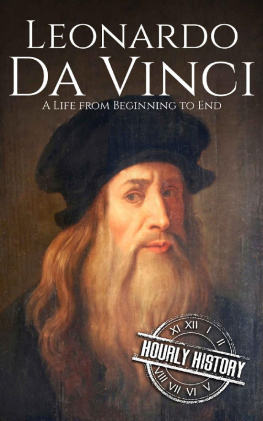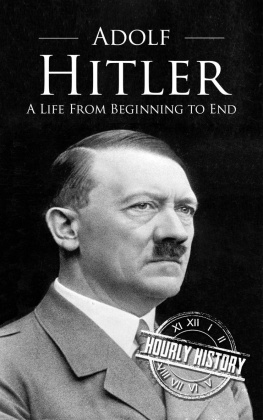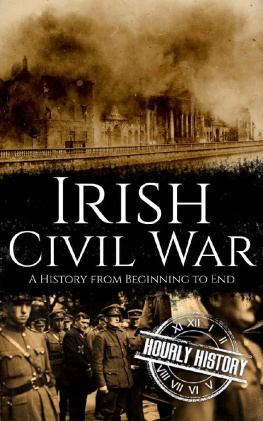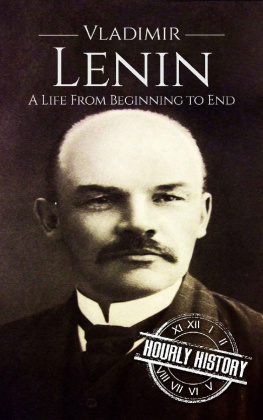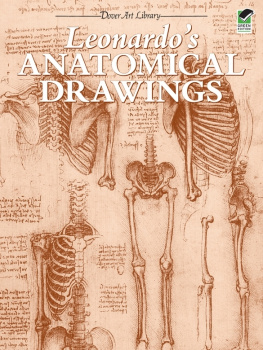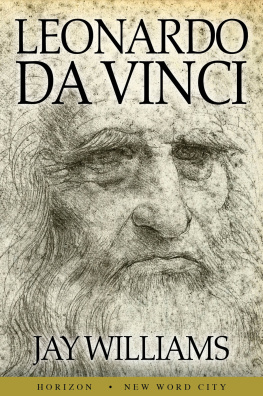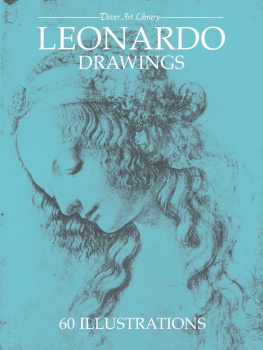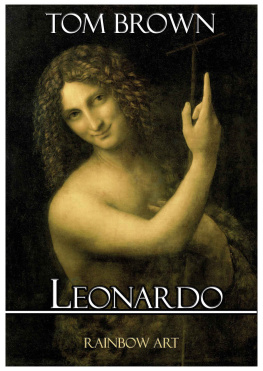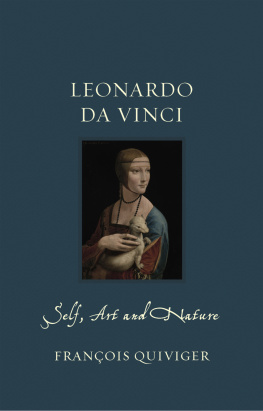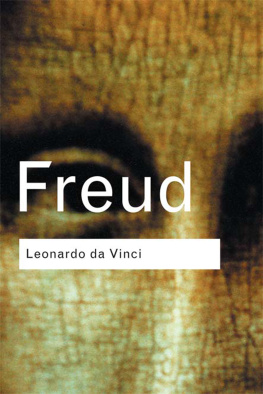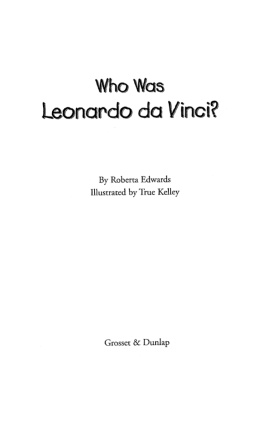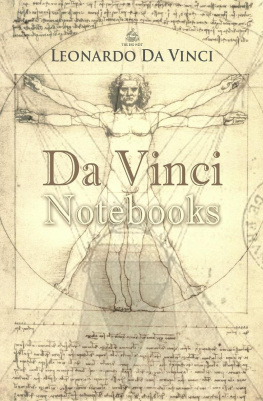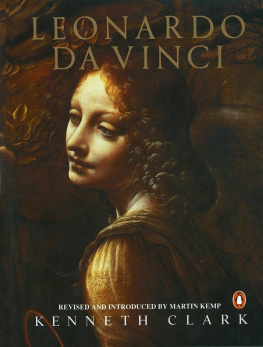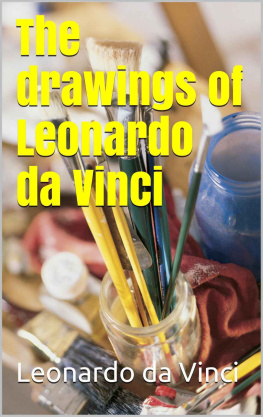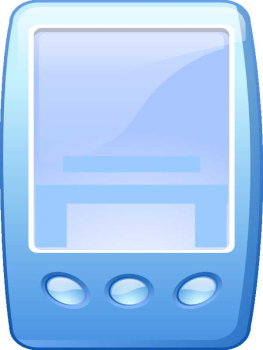LEONARDO DA VINCI
A Life From Beginning to End
Copyright 2016 by Hourly History.
All rights reserved.
Table of Contents
Introduction
If I were talking to you about a man called Leonardo di ser Piero, would you know who that is? Chances are you wouldnt. But, if I said Leonardo da Vinci, you would instantly recognize his name.
Both these people are the same man. Leonardo da Vinci would grow up to become the ultimate in what we think of as a Renaissance manin fact, he was the original. He embodied everything that was beginning to take root in Italy in the fourteenth through the sixteenth centuries, a time in history known as the Renaissance.
Leonardo seemed to be born with a curious mind and an intellect that demanded answers for every question which he posed about science, nature, painting, sculpture, architecture, inventions, military engineering, and drafting. He dabbled in all of these areas, and brilliantly, too.
Leonardo is known as one of the greatest painters who ever lived, and many argue he was the greatest artist ever. However, his genius went far beyond the easel and his paintbrushes. His mind could conceive of almost anything, from a beautiful representation of Heaven to graphical illustrations of the human body in a time when there were no such things as CAT scans or x-rays.
Leonardos lifetime was spent observing and doing so in many different venues. His notebooks were filled with examples of what it means to be human. He looked at life from numerous perspectives and recorded all he saw.
From light and shade to perspective and visual perception, from botany and landscape to physical sciences and astronomy, from architecture and planning to sculpture and experiments, from inventing to philosophy, there was nothing that didnt touch Leonardo da Vinci.
By the time of his death, Leonardo had seemed to capture the very heart of Europe. Everyone knew who he wasand this in an age when communication was slim to none. Quite an accomplishment for someone born a bastard in a remote Italian village no one had heard of. In time, he would become the favored one of popes, princes, and kings.
He was able to capture a time in history like no other. The European Renaissance was flowering out of the previous centuries and the Middle Ages. These new centuries, the fourteenth to the sixteenth, would not only challenge people but re-direct their thinking into ways that would introduce and recognize a more modern time. But, for that to happen, you needed extraordinary thinkers.
So, lets take a look at one of the most extraordinary thinkers of all: Leonardo da Vinci.
Chapter One
Early Beginnings and the Italian Renaissance
Learning never exhausts the mind.
Leonardo da Vinci
Leonardo was born on April 15, 1452, in the Tuscan hill town of Vinci. His mother, Caterina, was a peasant girl and was not married to Leonardos father, Piero Fruosino di Antonio da Vinci, who was quite wealthy. Leonardo had no last name, but was known throughout the region as Leonardo di ser Piero da Vinci meaning Leonardo, (son) of (Mes)ser Piero from Vinci.
Modern evidence uncovered suggests that Leonardos mother Caterina was a slave girl brought in from the Middle East. It was common for many prominent families in early Renaissance Italy to bring in women from Eastern Europe of the Middle East. Of course, Piero was never married to Caterina, only involved romantically with her.
Little is known about Leonardos early life, only that he spent his first five years living in Anchiano in the home of his mother. By 1457 he then lived with his father, grandparents, and uncle in the small town of Vinci. Leonardos father married several times during his childhood, and Leonardo ended up with twelve half-brothers and sisters. Most of these he had little to no contact with; they were known to give him a hard time over inheritance money. Even in centuries past, some things never change.
Leonardo received an adequate education, learning basic Latin, mathematics, and geography. He was never a stellar student, instead finding his attention on things other than what were found in classrooms.
The century in which Leonardo was born was the beginning of the Italian Renaissance. The fourteenth, fifteenth, and sixteenth centuries would become a time of great cultural upheaval and achievement in Italy as well as in all of Europe. The Black Death, which had ravaged Europe earlier in the fourteenth century, set the stage for the transition from the Middle Ages to a time of rebirth; hence the name Renaissance.
The Italian Renaissance is best known for its art and architecture as well as a new philosophy which was dawning all across the European nations at this time. Long-held beliefs about life, death, and everything in-between was now being challenged in every way. Thinkers and influencers were appearing where none had existed before.
This was a time when there were also major achievements in music, literature, and science. Italy became the leader in all of these endeavors. Italy in these days was a divided country; in fact, Italy would not unite until the nineteenth century. Instead, large areas of Italy were carved up by other European countries and used by them. The Italian Renaissance flourished in central Italy in the region known as Tuscany. This is where the city of Florence resides, and is where the rebirth began, spreading to other cities such as Venice and later, Rome.
Cultural awakenings were at the heart of the Italian Renaissance. Poetry was headed by Petrarch and Boccaccio, new architecture included St. PetersBasilica in Rome and Florence Cathedral, and literature ranged from The Prince by Machiavelli to Castigliones The Book of the Courtier, and these were just the beginning of the new thought that was coming to permeate all of Europe.
Nothing says Italian Renaissance better than the artists and their works. These painters and sculptors dominated the artistic scene in Italy for three centuries. Names that would gain great recognition and whose achievements echo down through the centuries to our modern day are all found here. These names include Fra Angelico, Domenico Ghirlandaio, Titian, Raphael, Botticelli, Michelangelo, and of course, Leonardo da Vinci.
Beauty, truth, religion, literature, even everyday life was being challenged in this remarkable time. What had been a disastrous time in the 1300s ushered in a more settled outlook as people were better fed and began having surplus money to spend on themselves. This, in turn, would bring on demand for more goods and services. To produce all of these, a growing class of bankers, skilled craftsmen, and a new middle class was beginning to emerge.
This was the Italy into which Leonardo da Vinci was born. Having only an education in basic reading and writing, Leonardo was taken by his father to apprentice to an artist known as Verrocchio, who had one of the finest workshops in all of Florence. Verrocchio was one of Florences leading sculptors and painters.
Here Leonardos training would have included learning about drafting, chemistry, metal working, leather working, plaster casting, carpentry, drawing, modeling, and painting. This would set the stage for his greatest achievements later on in his life.
Chapter Two
Leonardos Personal Life
I wish to work miracles.
Leonardo da Vinci
By the time he was five years old, Leonardo had moved into his father and grandfathers home in Vinci. The town sat near Mount Albano and was a lovely place with olive trees and orchards. Leonardos father Piero was away from home on business quite frequently, but his stepmother provided him ample affection.

